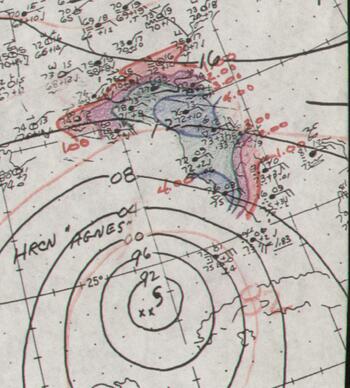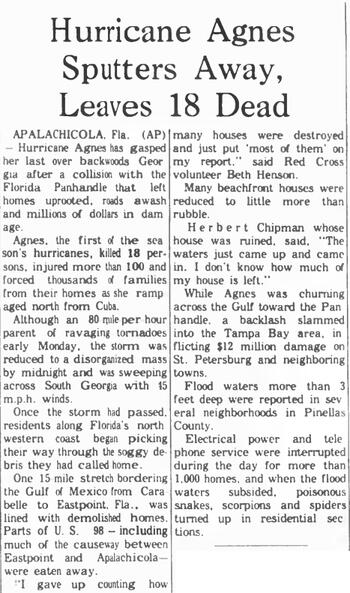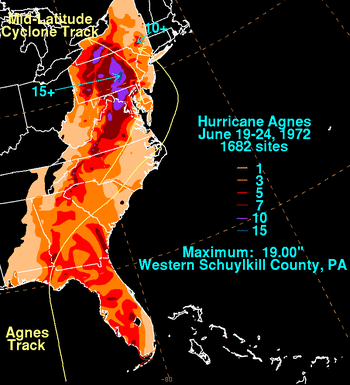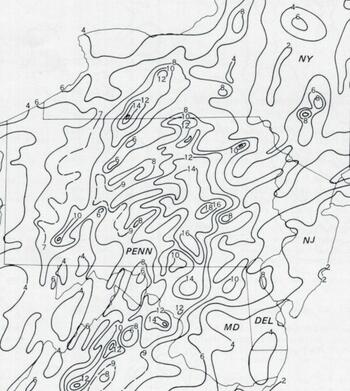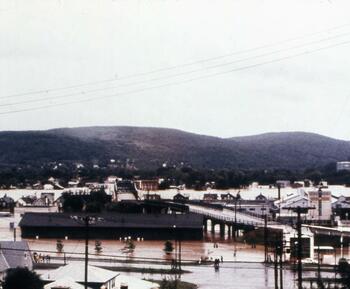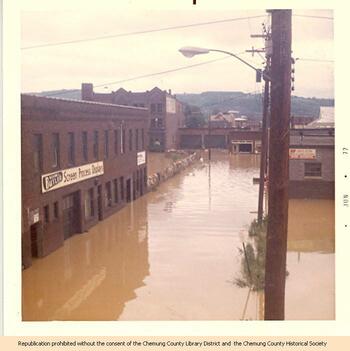Agnes was first identified as a tropical disturbance over the Yucatan Peninsula of Mexico on June 14, 1972. While Agnes grew in strength and became a tropical storm in the Gulf of Mexico, the middle Atlantic states of New York, New Jersey, Pennsylvania, and Maryland had already had a wet spring. New York's stream levels were above average and ground soil was already saturated before Agnes moved north.
The tropical disturbance was upgraded to a Tropical Storm on June 16, 1972 and given the name Agnes. The name "Agnes" has now been retired from the National Hurricane Center's naming list as the 1972 storm was extremely destructive. On June 17, with winds near 75 mph, Agnes was designated a hurricane.
Over the next few days, Hurricane Agnes ravaged the Florida panhandle with an unusually large diameter of over 1,000 nautical miles. Agnes' winds spawned at least 28 tornadoes, which caused widespread destruction over Florida, as well as seven lives lost.
By June 20, Agnes was significantly reduced in strength as it moved inland and northward. However, when the remnants of Agnes in North Carolina began to interact with a weather system from the Great Lakes region, Agnes was reignited to a Tropical Storm. Virginia was the first state to suffer flash flooding from sudden, severe rainfall on Wednesday, June 21. Pennsylvania and Upstate New York were next.
Rain continued through Thursday, June 22 across Virginia, Maryland, Pennsylvania, and New York. Tens of thousands of residents in New York were evacuated to higher ground as flood control infrastructure showed signs of failing. By Friday, June 23, over a foot of rain had fallen in less than 36 hours, and large regions were severely flooded. By the end of Friday, cities like Corning and Elmira were underwater.
Communities along the Susquehanna River into Pennsylvania continued to suffer through Saturday, June 24, as dramatic flooding destroyed thousands of homes. Rivers and creeks gradually receded over the next few days.
The flooding from Agnes set high water mark records in at least 48 recorded locations between Virginia and New York. Fifty years later, 38 of those records remain.
Hurricane Agnes surface analysis, June 18, 1972. Courtesy of the National Oceanic and Atmospheric Administration of the National Weather Service and Wes Junker.
This hand-drawn surface analysis of Hurricane Agnes' diameter on Sunday, June 18, 1972, shows its unusually large size for a June hurricane. Rainfall over Florida is marked in inches and color-coded.
Hurricane Agnes Sputters Away, Leaves 18 Dead. The Daily News (Batavia, NY), June 20, 1972. Courtesy of Old Fulton New York Post Cards.
This article from the Associated Press was printed in Batavia, New York, in Genesee County. It described the ravages left behind by Hurricane Agnes in the Florida region, just a few days before Agnes' rainfall would cause severe flooding throughout the Southern Tier.
Hurricane Agnes total rainfall, June 19-24, 1972. Courtesy of the National Oceanic and Atmospheric Administration of the National Weather Service and Wes Junker.
As Agnes lingered over the Middle Atlantic states for several days, rainfall totaled over 15 inches in the Twin Tiers region. For a region already saturated by an unusually wet June, this additional rainfall was too much to handle.
Hurricane Agnes Rainfall Amounts. Courtesy of the National Oceanic and Atmospheric Administration of the National Weather Service.
Another chart to show the incredible total amount of rainfall caused by Agnes. Pennsylvania was worst hit, although areas of the Southern Tier in New York recorded 14 or more inches.
Flooded Neighborhood in Corning. Courtesy of the Steuben County Historical Society.
The Chemung River bisects the city of Corning. Businesses and houses along the river were severely flooded and damaged.
Butler Screen Process Display Co. [1972]. Courtesy of the Chemung County Historical Society and Steele Memorial Library.
Elmira was especially hard hit by flooding. Commercial and industrial buildings along the downtown area were flooded, including the Butler Screen Process Display Company seen here.
